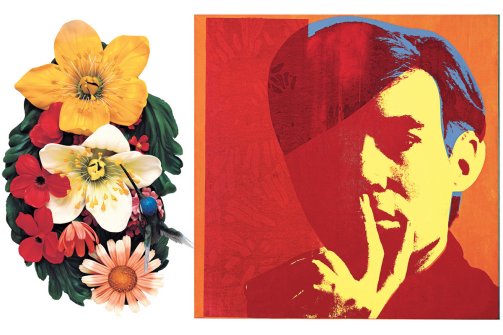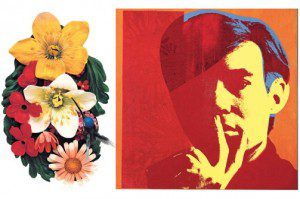
01 Oct TIO NYC: “REGARDING WARHOL” AT THE MET
“His ideal society has crystallized round him and learned to love his entropy,” Robert Hughes
Jeff Koons had a mother. His name was Andy Warhol.
I know. Hold the drumroll. No big reveal – except for the legions of kiddos, eyes round as saucers, eating it up, Campbell’s Soup and all. I am talking about the current blockbuster at the Metropolitan Museum of Art. We joined the throngs at “Regarding Warhol: Sixty Artists, Fifty Years,” (September 18 – December 31, 2012), last Sunday.
Turns out Koons was far from an only child (and the heir apparent). Warhol was like the little old lady who lived in a shoe. Koons had lots and lots of siblings and one huge extended family that included Alex Katz (whose portrait of Philip Glass among others is killer diller), John Baldesssari, Richard Artschwager, Ed Ruscha, Julien Schnabel, Richard Prince, Takashi Murakami, David Hockney, Jean-Michel Basquiat, Cindy Sherman, Nan Goldin, videographer Ryan Trecartin, plus a major branch of the tree from Germany (Signar Polke and Gerhard Richter among them), artists united by the idea that everything and nothing is special.
In Warhol’s world, there are equal signs between flowers, Brillo pads, electric chairs and Marilyn Monroe. Similar to Dada, it is all about location, location, location: in the the right context – a museum, a silver screen, a silver screen in a museum – elevates the subject matter. It all becomes art.
Or not.
My mentor, the (recently deceased) art critic Robert Hughes, was not nuts about Warhol. In fact he was known to growl when anyone put the name “Warhol” and the words “great” or “artist” in the same sentence. (Hence the quote above.)
Love him or leave him to history, there is no denying Warhol’s overarching influence on art history. The man was the pop of Pop art, a movement that included Jasper Johns, Robert Rauschenberg, and Claes Oldenburg, all of whom appropriated images from pop culture – advertising, news, comics, and quotidian objects – to make their point, often sardonically. If art is a mirror of life (Baudelaire) then what was reflected in Pop’s Windexed glass was the rapidly metastasizing cancer of mass media that defined America in the mid-20th century.
“Culture as Nature,” said Hughes.
Pop followed Abstract Expressionism. Think Jack the Dripper. And genre was in many ways a reaction to the physicality of the AbExers and their celebration of gesture and paint. Pop artists often used mechanical means of reproduction and rendering techniques to get their points across. Many of Warhol’s signature portraits of celebrities for example – Marilyn, Liz, Jackie – are Polaroid prints silk-screened on top of Day-Glo acrylic hues.
And there are traces of ABEx in the form of smears in Warhol’s earliest work, such as his Icebox, 1961. But that’s beside the point. The point is Warhol did not reflect the zeitgeist. He was the zeitgeist, the spirit of the age, in a world where voyeurism was a way of life and celebrities, (Warhol included), the new Greek gods and goddesses.
While Warhol, who died in 1987 at age 58 from complications around simple gall bladder surgery, is big business today, a mainstay of major auctions of contemporary art, the Met claims no exhibition to date has fully explored the full nature or extent of his influence. Juxtaposing 45 works by the maestro himself – paintings, sculpture, video – alongside 100 images by some 60 other artists, who reinterpret and react to his breakthrough creations,”Regarding Warhol” becomes a thought-provoking dialogue between works of art and artists across generations.
The kid from the blue collar family in Pittsburgh who started out his professional life as an ad man ultimately joined the pantheon of icons he worshipped as a young man. Warhol, who became not just a painter but also a film maker, whose unblinking camera focused on no one in particular, is credited by some with the origins of reality TV. He was also a publisher (the uber chic Interview magazine) and music producer (Velvet Underground, also the house band at Warhol’s studio-salon, The Factory). And gender fluidity was his middle name. (One entire room is dedicated to “Queer Studies”).
Warhol enjoyed way more than his 15 minutes of fame.



Sorry, the comment form is closed at this time.